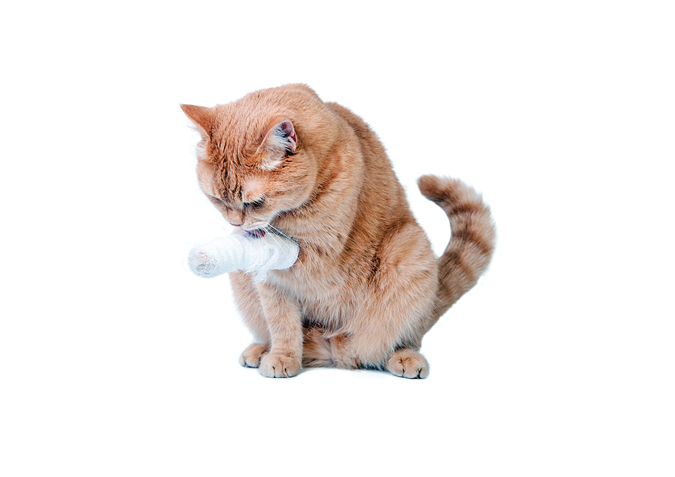Surgery is not a one-day vets-only game. It includes a recovery period at home where healing is paramount to the success of the operation.
Normal Healing
A typical incision should look neat and clean—healthy pink skin with the edges lined up, held closed by a row of sutures (stitches). Incisions can also be closed with the sutures buried under the skin so that they are not visible. When this is done, the skin may be closed with tissue glue. Surgical staples are another option to close an incision.
If your cat’s surgery involved multiple layers of tissue, such as going through muscle and the abdominal wall to perform a spay, each layer of tissue will have its own incision that is closed with sutures. This ensures that each layer is held in place to allow for quick healing. These inner layers will be closed with absorbable suture that will dissolve over time or, in some cases, with a suture type that is safe to leave inside your cat’s body.
For the first few days, the skin around your cat’s incision may look a little irritated due to local inflammation that is part of the normal healing process. Small amounts of clear or slightly blood-tinged discharge may be present, and bruising may appear up to several days after the surgery, particularly in pale-skinned cats.
Don’t be concerned about the length of your cat’s incision. Incisions heal from side to side across the gap rather than from end to end, so a two-inch and a four-inch incision will heal in the same amount of time as long as other factors remain equal. A long incision that has been closed well with the edges close together will heal more quickly than a small wound that is left open.
Cleaning the Incision
If you need to clean discharge from around your cat’s incision, use a clean cloth or gauze slightly moistened with warm water and be very gentle. Avoid alcohol and hydrogen peroxide unless instructed by your veterinarian, as these products can cause discomfort and slow healing.
While the complete healing process can take several months as the skin cells remodel and return to their normal state, the first two weeks are the most important time for incision care. For sutures closed with non-absorbable suture or with staples, you will usually be instructed to bring your cat in for suture removal 10 to 14 days after surgery. This gives the incision time to heal so that the sutures are no longer needed to hold the edges together.
What Can Go Wrong
“The most common complications would be an incision that opens up (a dehiscence) or an incision that becomes infected,” says James Flanders, DVM, DACVS, Emeritus Associate Professor Section of Small Animal Surgery at Cornell. “Although a gap in an incision that occurs a few days after surgery may be due to a missed suture bite on the part of the surgeon, most incision issues in dogs and cats are due to the patients themselves. If there are sutures present in the skin or if there is any discomfort or itching from an incision, then dogs and cats are going to want to chew, lick, or scratch at the incision.”
Incisions may become itchy due to local inflammation during the healing process, nerve regeneration in the skin, or from hair growing back in. If your cat tries to scratch or lick the itchy incision, he can rip out sutures or damage the healing skin. This allows the incision to open, slowing the healing process and promoting infection.
Too much activity can also damage an incision, especially if it is under a lot of tension (such as an incision over a joint or a site from which a large amount of skin has been removed). As the cat runs and jumps, he can put extra strain on the sutures and can cause them to break or to rip through the skin. Even if the incision remains intact, too much activity can cause extra fluid buildup under the skin resulting in swelling.
Dehiscence
Dehiscence is when an incision ruptures and opens. If an internal layer of sutures ruptures, you may notice a new bump under healthy normal skin or tenderness in that area. If the external incision dehisces, the incision will be open. Dehiscence can allow fat, muscle, and even internal organs to herniate out of their normal positions.
Depending on the severity of the dehiscence, it may be necessary to put the cat back under anesthesia to repair the incision. Small openings that only involve a few stitches or in an incision that has mostly healed may be able to either be closed with tissue glue or left to heal on their own. An internal dehiscence requires a veterinary examination, but may be left to resolve on its own unless it is complicated by tissue herniating through the opening.
In most cases, dehiscence occurs because a cat has either been allowed free access to the incision and damages it directly, or because the cat has been too active and damages it that way. Dehiscence can also occur if the tissues are compromised and unable to support the tension of the incision—this could happen after a large wound repair if the tissue becomes necrotic, or after the removal of a large mass. This is not common for routine surgeries, and your veterinary surgeon will warn you if there are concerns about the incision’s integrity.
Infection
“A normally healing incision will rarely become infected unless a gap is created by the pet or by other trauma,” says Dr. Flanders. Most surgeries are performed in a sterile environment from start to finish, limiting the introduction of pathogens into the surgical site. “Dirty” wounds, such as abrasions from being hit by a car or punctures from a cat bite, are a different story and are highly likely to be contaminated. Surgical procedures done in the mouth or to repair a wound fall somewhere in the middle, and the veterinarian performing the surgery will determine whether or not the wound should be completely closed or if a drain should be placed to allow for drainage (this is common for cat-bite abscesses). If the surgeon has concerns about contamination either before the surgical repair or during the recovery period, antibiotics may be prescribed as a preventive measure.
So how can a standard sterile incision become infected? No matter how skilled the surgeon, an incision is still technically a wound that can allow bacteria to enter the body. If the cat or other pets in the household lick the incision, any bacteria on their tongues can be transferred to the incision and pose a risk for infection. Incisions on feet and legs can come in contact with litter in litterboxes. And of course, if the cat is running around like a maniac and manages to tear a suture, the now-open incision is an even wider entryway for opportunistic pathogens.
Signs of an infected incision include redness, swelling, discharge, and heat. Your cat may act uncomfortable and limp if the incision is on a leg or hunch his back if it is an abdominal incision.
If you suspect your cat’s incision has become infected, he should be seen by a veterinarian promptly. Antibiotics will usually be started, and a culture and sensitivity may be obtained to guide the correct choice of antibiotics. If an abscess has formed, it may be necessary to flush the wound and place a drain.
What You Can Do
- Follow post-surgery discharge instructions closely.
- Restrict your cat’s activity.
- Use a head cone or other protective device to prevent your cat from damaging the incision.
- Monitor your cat and his incision.
- Keep your cat indoors.
- Contact your veterinarian promptly if you have any questions/concerns.
Seromas
A seroma is a pocket of fluid (serum) that can form between tissue layers at a surgery site. These are usually neither painful nor infected, and usually occur because the cat has been too active. They tend to develop within a few days after surgery, but can show up later.
If you suspect your cat has a seroma, he should be seen by your veterinarian to determine the best course of action. In most cases, you will be instructed to get more serious about restricting your cat’s activity and to alternate warm and cold compresses over the area to encourage the swelling to go down and the fluid to disperse. If the seroma is draining through the incision, antibiotics may be prescribed to prevent an infection.
Protective Measures
“Unfortunately, there are few places on their bodies that cats can’t reach with their mouths or their feet! This is why it is so common to send animals home with an Elizabethan collar,” says Dr. Flanders. Your cat’s veterinary team will likely go over some options to protect your cat’s incision at the time of discharge, but you can also figure much of that out based on your cat’s anatomy. Any incision on his legs or trunk can be accessed by his mouth. Incisions on your cat’s head and neck may be out of reach of his mouth, but can be reached with multiple paws.
In addition to the standard plastic cone (Elizabethan collar), you can use a soft, inflatable “donut” collar, baby onesie, bandage, or a cat bodysuit to protect the incision, depending on its location. Some cats also tolerate wearing socks or booties to cover their claws and prevent scratching (nail caps will lessen the potential for trauma to the skin from scratching, but do not eliminate the risk of a nail getting stuck under a suture and ripping it out). Unless your cat is under direct supervision, he should be wearing protective gear to keep his incision safe.
Some incisions are more likely to develop complications than others. “The most common incisions are the most common ones to have complications!” says Dr. Flanders. “Spay and castration incision problems pop into my mind immediately.”
Affected cats are usually young and playful, so they want to get back to their active lifestyles within days of having surgery. Overactive cats should be confined to a room without furniture that they can jump on and off of or to a large crate for at least the first week after surgery. They should also be kept separate from other cats to prevent play and roughhousing.
“Also, incisions over joints (like the knee or elbow especially) or areas of motion are an extra challenge to get to heal,” says Dr. Flanders. “There is constant stress on the healing incision so a bandage to reduce motion is often needed along with some careful suturing.” These cats must be kept confined to prevent them from putting excess strain on an already tight incision.
Your cat should also be kept indoors until the incision has healed and any sutures removed. If the incision is located on a leg or paw, paper-based litter such as Yesterday’s News is a good option for the litterbox to limit the risk of litter getting stuck in the incision and causing an infection.

He Hates the Cone!
While it is true that no cat would choose to wear a cone, most of them adjust to it quickly. If your cat panics with the plastic cone on or keeps slipping it off, you can try something else to keep him away from those sutures: a soft cone, inflatable “donut” collar, onesie, bandage, or bodysuit, depending on the location of the incision. Ask the staff at your veterinary hospital for suggestions.
You can take the cone off for mealtimes if needed, but watch him the whole time. Even if he does not appear to be interested in his incision, leaving it unprotected is a risk. He may start to lick and chew at it when the hair starts to grow back and becomes itchy, or may catch a suture with a nail when scratching. If he damages the incision, it means a return trip to the vet, which your cat probably won’t like either.



